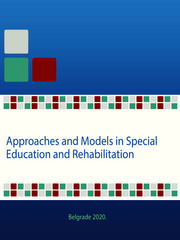Приказ основних података о документу
Sensory processing of persons with autism spectrum disorder
| dc.contributor | Nedović G. | |
| dc.contributor | Eminović F. | |
| dc.creator | Roknić, Ana | |
| dc.creator | Ninić, Nataša | |
| dc.date.accessioned | 2021-10-11T10:39:14Z | |
| dc.date.available | 2021-10-11T10:39:14Z | |
| dc.date.issued | 2020 | |
| dc.identifier.isbn | 978-86-6203-139-6 | |
| dc.identifier.uri | http://rfasper.fasper.bg.ac.rs/handle/123456789/3528 | |
| dc.description.abstract | Sensory processing is a complex, neurobiological process in which a person uses his/ her senses, experiences information or stimuli from the environment, sends information to an appropriate centre for receiving and processing information, and responds to environmental stimuli. Sensory processing is the base of mental and social functioning, leading to the development of complex abilities at an older age. The authors emphasize the importance of the first seven years of life for the adequate development of sensory processing and therefore emphasize the importance of early intervention. Symptoms of incomplete sensory processing are manifested by atypical behavioural reactions in response to sensory stimulation. Atypical sensory processing stands out as a specific and universal symptom of people with autism spectrum disorder and most commonly manifests as hypo or hypersensitivity to various sensory information. This paper aims to review and analyze the studies examining the specifics of sensory processing of persons with autism spectrum disorder When reviewing the literature, all studies clearly show that individuals with autism spectrum disorder exhibit pronounced specificities in all domains of sensory processing. The most common problem is the processing of auditory information. Responses to sensory stimuli are context-dependent, in which a person may appear hypersensitive in a particular situation, while in another situation he may be hyposensitive to the same stimulus source. In addition to hypo and hypersensitivity the problem of sensory integration and detection of stimulus sources is often manifested in these individuals. More recent studies also report the relatively frequent occurrence ofdistortion, synesthesia, and sensory-specific satiety. Following the above findings, in order to plan adequate defectological treatment, it is necessary to take into account all the specifics of sensory processing of persons with autism spectrum disorder | sr |
| dc.language.iso | en | sr |
| dc.publisher | University of Belgrade – Faculty of Special Education and Rehabilitation Publishing Center of the Faculty | sr |
| dc.rights | openAccess | sr |
| dc.rights.uri | https://creativecommons.org/licenses/by-sa/4.0/ | |
| dc.source | Approaches and Models in Special Education and Rehabilitation – Thematic Collection of International Importance | sr |
| dc.subject | autism spectrum disorder | sr |
| dc.subject | sensory processing | sr |
| dc.subject | hypo/hypersensitivity | sr |
| dc.title | Sensory processing of persons with autism spectrum disorder | sr |
| dc.type | conferenceObject | sr |
| dc.rights.license | BY-SA | sr |
| dc.citation.epage | 275 | |
| dc.citation.spage | 263 | |
| dc.identifier.fulltext | http://rfasper.fasper.bg.ac.rs/bitstream/id/3348/bitstream_3348.pdf | |
| dc.identifier.rcub | https://hdl.handle.net/21.15107/rcub_rfasper_3528 | |
| dc.type.version | publishedVersion | sr |


